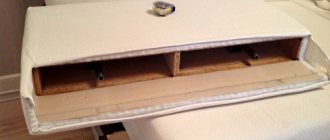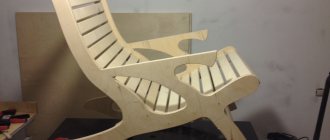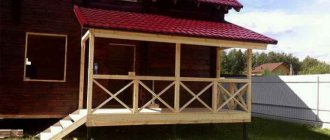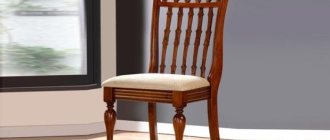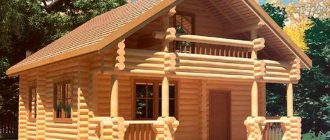A chair for your home or garden can be purchased at any furniture store. There they are presented for every taste and budget.
However, there is no need to rush into purchasing. You can make such furniture yourself. It will not be inferior in reliability and attractiveness to store models and, moreover, will be exclusive.
Soft chair
A classic option, it’s convenient to drink a cup of tea, read, or watch TV.
What can you use to make a frame for an upholstered chair with your own hands:
- bars;
- boards;
- plywood;
- logs;
- chipboard;
- metal, etc.
When choosing a model, it is necessary to take into account not only the complexity of manufacturing, but also the interior of the room where it will stand.
Below is one of the simplest options.
Original ideas
The types of seat designs are incredibly varied. Your imagination and a little effort are the key to creating original and fashionable furniture.
Now many designers take advantage of this and create a huge number of unusual chairs with intricate shapes.
Nowadays the nest chair is considered very fashionable. It can stand firmly in place or be suspended from the ceiling.
Comfortable furniture, ideal for relaxation in a small room - a mini-chair. It is suitable for any design, so it is very popular now.
The dream of many people is a rocking chair. There are a huge number of them on sale now. You can also easily make it yourself, you just have to want it.
Tools and materials
Before starting work you need to prepare:
- plywood sheet;
- soldering iron;
- hacksaw;
- hammer;
- meter;
- compass;
- strong scissors;
- drill;
- self-tapping screws;
- screwdriver or hexagon;
- fabric and foam rubber;
- glue;
- paint;
- metal rims;
- stapler
Painting
For painting, I took for testing decorative impregnation for wood FH-015 from FORUMHOUSE in chestnut color, suitable for both interior and exterior work. For painting you can use a brush, roller or spray gun.
The first point that I immediately liked: on all such cans it is always written “stir thoroughly before use”; this was not the case with this one. The impregnation, carried out in mid-2021, turned out to be completely homogeneous and immediately ready for use.
Second: the smell that we are used to feeling during painting work is completely absent; you can safely paint even in unventilated areas.
Third: the paint is very plastic and not flowing. I painted all the parts in two layers, and only the tip of the brush was dirty.
Fourth plus: drying speed. Yes, the can says 12-24 hours, but I don’t know under what conditions this is. Because I applied the second layer 1 hour after the first on completely dry parts, and the chair was assembled after 4 hours after the painting had started.
Fifth: efficiency.
It took me 100 grams for the first layer, no more than 50 for the second!!! This is what the jar and all the details looked like after two layers:
The coverage of the paint is excellent; you actually brush it once, and all the paint from the brush is applied in an even layer to the surface.
Now all that remains is to check its durability.
Step by step process
Step-by-step instructions on how to make a chair:
- Cut out templates from cardboard. In the future, they will be used to produce plywood elements.
- Prepare cross bars for the frame. In this case, you need to decide in advance on their slope, bend, size (they depend on your preferences).
- Sand the wooden components. Paint the sides and reinforce the ends with metal elements.
- Secure the foam rubber to the back and seat with glue. Secure the top with a stapler for reliability. Additionally, the armrests can be trimmed with material.
- Pull the fabric over the back, and then over everything else. To do this, you need to make holes with a screwdriver and secure the rims with self-tapping screws.
- Connect all parts with screws. Treat the joints and fasteners with additional glue.
Where do we start?
From rocking chairs. A homemade rocking chair will provide the most significant savings in money compared to purchased ones - once. Its production is technologically simple; As for stationary equipment, it is enough to have a workbench (possibly also homemade) in some nook or two. And it will always come in handy at the dacha, even if the design with finishing from an inexperienced craftsman was screwed up - three. But you need to make a rocking chair with your own hands only and only according to proven samples, and you can design it yourself only if you have considerable experience as a furniture maker and/or solid knowledge in this matter.
The design of rocking chairs is similar to the design of sailing ships. There, the center of sail (CS), the location of which depends on the configuration of the surface part (most of all, the sailing rig), the direction and strength of the wind, should always be slightly behind the center of rotation (CV) of the vessel. The location of the central point is determined by the interaction of the underwater part of the vessel with the incoming water flow.
If the CP is ahead of the CV, the ship will be prone to yaw while moving and will have trouble staying on course, and with the tiller/wheel abandoned, it will fall to the wind and end up with the lag (side) to the wave, which is fraught with disaster. If the CP is far behind the CV, the ship without a rudder will be driven towards the wind and will take the wave on the bow, which is safer, but it will respond to rudder turns sluggishly and slowly, which also threatens to crash. Therefore, sailboats are designed so that during any evolutions of the vessel (maneuvers + changes in sail in any possible sailing conditions), the CPU behaves like a sly fox with a dog: it “teases” the CV, staying close to it from behind, but then immediately runs away a little, As soon as the CV comes close. In this case, the ship will be quite agile, but the uncontrollable one will still be driven into the wind.
In a rocking chair, the role of the CP is played by the common center of gravity (CG) of the chair and the person sitting in it, and the role of the CV is the line of contact (LC), passing through the points of contact of the support shoes (arcs) of the floor or ground. If the CG is far ahead of the LC, it will be difficult to swing, and when leaving the chair you can get, excuse me, a kick from him. If the CG is behind the LC, then an “overkill turn” is possible, which is not at all funny: doctors are well aware of cases where people broke their necks by tumbling over their heads from homemade rockers. That is, for a rocking chair to be safe, convenient and comfortable, its CG with a rider of any corpulence should always be slightly ahead of the LC.
Note: for reference, the CG of a normal-built human body is located at the border of the lower back and sacrum on the inside of the spinal column. During movements and in different poses, its position changes little - over millions of years of evolution, a kinematic system has been developed that allows us not to fall on our side with our arm outstretched.
Rocking chair designs
Due to the above, the first rocking chairs appeared relatively late, no earlier than the middle of the 18th century. By that time, science had given technology methods for calculating complex mechanical systems in dynamics and the first steam engines were chugging along. As for the rocking chairs, their classic design is arches elongated posteriorly with a radius of curvature smoothly decreasing from front to back, pos. 1 in Fig. In such a system, the further the seated person pumps back, the further the LC will move back from the CG and it will be more and more difficult to pump out until the stopper is reached - the rear ends of the arches turn into straight lines. This is the so-called. reverse-progressive support. It is often called simply progressive, because. a truly progressive one will throw the rider backwards from the slightest push and therefore is not used. For ergonomic reasons, progressive arches are not always comfortable (if someone steps on the heel of the arch, the rider will jerk), so at the same time they came up with the idea of moving the rocking chair forward, which shifts the overall CG there, pos. 2, but such chairs are only suitable for people whose body type they are designed for.
Rocking chairs on various types of support arches
The best way to create a rocking chair that is comfortable for anyone is to put arches on springs, pos. 3. At first, springs were made of wood, teak or dogwood (there is no replacement). Now rocker springs are made of carbon fiber (carbon, Kevlar) or special steel. Rockers on springs, in addition, swing for a long time and smoothly from a small push, lulling the rider in the most gentle way.
The simplest in design and the most safe are rocking stairs, pos. 4. In them, the stringers also serve as arcs, and the large length of their forming parts guarantees against tipping over. But single rocking stairs are chairs for individual use. If someone else sits in this one, with a CG that is even slightly shifted from the calculated one, it will either be difficult for him to swing, or he will find himself lying with his knees towards the sky. Therefore, according to the staircase design, as a rule, a pair of garden chairs or rocking benches are made. In this case, the general CG of the riders is less likely to leave the calculation area, and the large supporting area of the arcs ensures rocking when the rocking chair is installed directly on the ground. The structure and dimensions of a paired garden rocking chair are shown in Fig. Seat upholstery – slats 30x50; valleys - board 100x30.
Pair of garden rocking chairs
Drawings of a classic rocking chair
Product samples
On the trail. rice. – drawings of a classic rocking chair, relatively simple and not particularly material-intensive, but suitable for both the country house and the living room. In the latter case, the seat and back cushions are made 5-7 cm thick using the technology described below.
The next option is a garden rocking chair made of boards, see fig. Widened arches are designed for installation on the ground. When creating the design, we took into account the fact that on a lawn or gravel you won’t be able to sway for a long time from one push anyway. This made it possible to move the CG more forward from the LC by moving the seat, and use simple radius arcs. In addition, the resulting margin of stability made it possible to make the backrest adjustable in angle.
Drawings of a garden rocking chair with an adjustable backrest
Rocking chair in fig. above, it is structurally already close to a rocking chair-chaise lounge, in which the fixation of the rider’s CG relative to the PC is ensured by his very pose; simply - a rather deep failure of the dearest parts and, accordingly, a low-lying general CG. Drawings of a pair of rocking chairs are shown on the following. rice. On the left - it looks more elegant, but it is material-intensive: for each of the shaped sidewalls you will need a whole sheet of plywood 20 mm thick. On the right - simpler and more economical. Arcs 60 mm wide, 4-layer: 2 middle ones are cut out together with the corresponding parts of the side panels from 15 mm plywood, and overlays, cut separately, are added to them. All this together makes the structure very strong, and the additional downward displacement of its own CG due to the heavy arches makes it quite resistant to overturning.
Drawings of rocking chairs
Additional information about the options, history and designs of rocking chairs is well described here.
What is necessary
Before starting the work process, you need to prepare:
- 3 m calico or satin;
- a piece of fabric for covering (approximately 3.5 m);
- zipper 1 m;
- filler;
- material for application;
- scissors, pins, thread and needles.
Check it out here too!
How to make a bench from pallets: do-it-yourself bench from palletsInstructions on how to make a table with your own hands: step-by-step photo instructions, drawings, assembly diagrams for tables of different types for the garden and at home
How to make a hanging chair with your own hands - 100 photo ideas for chair design, instructions for their implementation. Creating the perfect vacation spot
What if there is no carpentry?
Although shavings and sawdust are not dirt at all, wood processing is quite a garbage business. At the same time, modern materials and cutting methods make it possible to create printed garments that hold their shape under load without a frame. This is perhaps the main reason that frameless upholstered furniture is gaining increasing popularity among craftsmen and amateur craftswomen. The most common are embroidered chairs, because... the whole essence of a home chair is soft elasticity and, in general, it doesn’t need a functional frame.
Construction of a frameless bean bag chair
The structure of a sewn chair is shown in Fig. The purpose of the double cover, the choice of fabric and filling are described above; Here we only note that there is absolutely no need to put a zipper on the inner cover. Both covers are sewn inside out and the last seam of the inner one after filling in the filler is sewn up with the scar facing outwards. It’s easier, cheaper and more reliable, and the scar is still not visible. Before sewing the last seam or installing the fastener, the cover is turned inside out.
The last (detachable) seam of the outer cover should be 0.8-1 m long, because through it you will have to put the outer cover on the inner one that has taken shape. If the filling is solid (foam rubber, neoprene block), 2 half-length zippers are placed on the detachable seam, fastened towards each other, otherwise the inner bag will get stuck in the asymmetrical cut.
Homemade grommet
If the zipper is replaced with lacing, the allowances along the edges of the split seam are folded and ironed before turning the cover inside out, a thick, strong braid is inserted into the lapel, and the wings of the lapel are quilted. Then, using a hole punch, holes for the cord are punched in increments of 4-6 cm and framed with eyelets. In extreme cases, the holes are cut with petals, a ring of wire or durable plastic is applied, the petals are folded through it and glued with PVA; then the grommet is tightly covered with a harsh thread (see figure on the left) and glued again. Several types of chairs fit into this general design and sewing scheme.
Note: processing allowances are everywhere within 15-30 mm.
Pillows
Who, as a child, did not lie on a pillow placed upside down? The simplest sewn chair is a large pillow. But it’s only good for fun, but it’s not good for relaxation: either there’s no back, or there’s something sticking out between the legs. It also easily wrinkles and falls to the side. Therefore, the cushion chair is made only to look like a pillow under the head, but in fact it is quite ergonomic and stable.
Patterns of armchairs-pillows
The easiest way is to pattern a cushion chair according to pos. and on the left in Fig. There are only 2 parts with a bend, and even then a simple radius one. Filler – foam rubber. But this “pillow” looks angular and doesn’t really look like the real thing. To get a more elegant chair that looks more like a real rumpled pillow, pos. b, you need to reduce the bottom, narrow the back, and trim the remaining parts obliquely by 5 cm, as shown in Fig. In this case, the filler is foam or neoprene.
Ottoman
Structurally and in terms of material consumption, a chair-cushion is similar to a chair-pouf, like a footprint. rice. It is more difficult to tailor, but pouffe chairs have an important advantage: they are suitable as a play and recreational children’s chair “from zero to school.” But not a working chair, a high chair, or other functional children's furniture! Having got used to falling apart on something soft, the child runs a great risk of ruining his posture!
Bean bags for children
Pouf chairs are most often sewn according to a pattern of 3 parts: shell (ring sidewall), seat, bottom. But in operation it turns out that the only vertical seam (or zipper) soon separates or breaks. Therefore, it is best to sew a pouffe chair from 5 parts with an insert at the front, as shown in Fig. The liner works similar to the stitching on the toes of work or military boots. It doesn’t look good on weekend shoes, but the chair liner can be made decorative, and there won’t be any extra seams on the shell.
Sack and pear
It’s not far from a pouffe chair to a bean bag chair with a higher back. The simplest bean bag chair can be sewn from 3 parts, as on the left in Fig. The front vertical seam, due to the support of the rider on the back, is less loaded and quite reliable.
Patterns of a bean bag chair and a pear chair
A simple bean bag chair has its drawbacks: the filling, especially foam, tends to spread out, and the back does not provide full support. You won't fall apart in such a chair with all your heart; your back will be damaged. The pear-shaped chair on the right in Fig. is free from these ailments. Option of cutting the bottom (bottom) No. 2 allows you to save approximately 0.5 m of fabric with a width of 1.44 m, because When marking the cut, parts according to option No. 2 can be squeezed between the wedges. In any case, the zipper is located along the diameter of the bottom.
Ball
An excellent option for a sporty child or adult is a ball chair, see fig. Cutting fabric for it is not so difficult if you use not the dimensions from the network, which are most often incorrect and not tied to anything, but the radius of the generatrix and the central angle of the polygon. In Fig. they are given for a ball chair with a diameter of 80 cm; for a diameter of 60 cm it will be 165 and 128 mm, respectively, at the same angles.
Ball Chair Element Templates
Sewing a ball chair has some features:
- Because The detachable seam is short, the cover will have to be sewn single from antistatic fabric.
- To prevent errors from accumulating during sewing, which will negate all the work, the polygon templates are carefully checked, applying sides to each other. All sides of both templates must be the same length to within 0.5 mm; for an 80 cm ball – 100 mm. Unusual for cutting work, right? But when sewing, the error accumulates. For 20 6-gons + 12 5-gons, the discrepancy can reach 0.5x32 = 16 mm and then the corners cannot be reduced by any tightening.
- The filler is poured into the cover through a rolled-up cardboard pipe with a diameter of 60 mm. You can use a piece of plastic.
- If the ball is laced, the split seam is made with a valve, like in old leather soccer balls, so that the filling does not spill out.
Note: the filling volume for the described chair-cushions and 80 cm ball is about 250 l, and for the bag and pear about 350 l. The internal volume is filled completely, then washed.
Like real
Here in Fig. – frameless chair with foam filling, simulating a cabinet chair. Armrests, if needed, are sewn like a backrest. The entire product can serve as a module from which a sofa, chair-bed, etc. can be assembled. The base is foam rubber slabs of grade (density) 40-45, 10 cm thick, glued together with PVA in pairs to a thickness of 20 cm, pos. 1. Seat and foot zippers are located at the back, and backrest/armrest zippers are located at the bottom. They must be paired, pos. 2, because it is very difficult to push the foam rubber in any case into a deep cavity through an asymmetrical split seam.
Frameless chair for an apartment
Note: in the same way, but from foam rubber of a smaller thickness, the seat and back cushions of some of the chairs described above and below are made.
The tongues for sewing together chair elements about 10 cm wide (pos. 3) do not provide a complete guarantee against sideways displacement with distortion, so pairs of buttons, pos. 4. The backrest/armrests are sewn filled before filling the seat, and the seat and backing are sewn together after.
To prevent the lower (folded) decorative trim from getting dirty and rubbing against the floor, it is advisable to place the chair on a plywood or plank pallet with low (approx. 5 cm) legs. It unfolds through the bottom, pos. 5. In this case, you get a good temporary, say, at the dacha, crib for a child. And if you save a little on foam rubber and lengthen the legs due to the chosen height, you will get a good chaise lounge for the veranda, pos. 6. So that, again, the lower (when unfolded) edge of the footrest does not wear out, it is sheathed, including a corner, with technical fabric. When folded, the upholstery will be at the back between the pillows and will be almost invisible.
Manufacturing
How to make a bean bag chair with your own hands:
- Prepare all fabric parts. You can download your favorite pattern for a chair cover with your own hands from the Internet and bring it to life. The upper and lower parts are sewn separately. The result should be: a miniature bottom on one side, a large one on the other, and 6 fabric wedges.
- Topstitch and sew the bag. Leave only a small area for filler.
- Install a zipper on one of the wedges of the upper bag. This way the cover will be removable, which is very convenient for washing when dirty.
- Cut out the appliqués and sew them on top of the bag.
- Fill 2/3 of the filler into the inner case. You can use padding polyester.
- Place one bag into the other and zip up. The chair is ready for use.
When making such a product, you need to make very strong seams so that they do not come apart under the weight of the person sitting.
Work planning
As with all things, creating a work plan is the most important part of getting off to a productive start. You need to think carefully about what your future furniture will be like.
Understand that making a chair from a frame is more difficult than building a frameless structure. But they look more solid than frameless chairs.
A very important role in achieving success in working on the design of a bean bag chair depends on how correctly you made the diagrams and drawings for making the chair.
In addition, before making such furniture, you should not forget about the correct calculation of the required amount of money so that your subsequent work is not disrupted by any circumstances.
How to do
Step by step steps:
- Sand all parts, mark fastening points with chalk or a washable marker.
- Cut out the sides of the furniture from plywood according to the pattern.
- Connect the sides at the top and at the level of the seat support with drawers.
- Attach the strips to the resulting frame at a distance of 2.5 cm.
- Round the edges.
- Coat the product with varnish.
Choosing fabric for upholstery
The first step in the manufacture of home upholstered furniture is the choice of fabric for the external design of the soft parts of the structure. Each master selects upholstery depending on the physical properties and price aspects and features that different drawings have. Let's look at the most common fabrics for decorating chairs in our time:
- velor – velvety to the touch, gives the furniture a certain charm;
Velor upholstery
- flog is a distant analogue of velor, easy to clean, so designers use it to decorate children's upholstered furniture;
Upholstered flog
- chenille - a fabric based on a combination of natural and synthetic fibers, has particular wear resistance (a well-thought-out structure prevents the formation of pilling);
Chinille in upholstery
- jacquard - the upholstery is considered durable, but over time the loops turn into puffs;
- natural tapestry is the most expensive and beautiful type of fabric for upholstery;
Upholstered jacquard
- artificial suede is a universal option for chairs in a sunny room, resistant to UV rays and easy to clean;
Faux suede upholstery
- leatherette is a durable material that allows you to play with decorative embossing.
Leatherette upholstery
Photo of the chair with your own hands?
Check it out here too!
DIY furniture made of wood: the best photos of solid wood furniture! The process of making wooden furniture: drawings, diagrams, furniture assemblyHow to make book shelves with your own hands: drawings and step-by-step photos. Wall shelves, floor standing, portable, Montessori book shelf
We make a kitchen countertop with our own hands: design, methods of application, design options and decor ideas (135 photos and videos)

